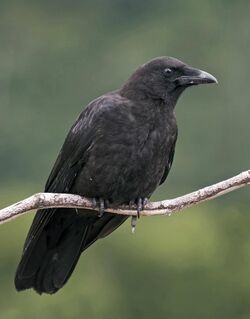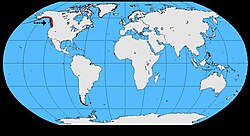Biology:Northwestern crow
| Northwestern crow | |
|---|---|

| |
| Scientific classification | |
| Domain: | Eukaryota |
| Kingdom: | Animalia |
| Phylum: | Chordata |
| Class: | Aves |
| Order: | Passeriformes |
| Family: | Corvidae |
| Genus: | Corvus |
| Species: | |
| Subspecies: | C. b. caurinus
|
| Trinomial name | |
| Corvus brachyrhynchos caurinus Baird, 1858
| |

| |
| Northwestern crow range | |
The northwestern crow (Corvus brachyrhynchos var. caurinus) is an all-black passerine bird of the crow genus native to the northwest of North America. It is a clinal variant of the American crow (Corvus brachyrhynchos), but it averages slightly smaller (33–41 cm in length) than other subspecies. With the exception of calls, this taxon is perhaps impossible to identify in the field, and is largely identified by range.
Taxonomy
This taxon was described by Spencer Fullerton Baird in 1858.[1] The American Ornithologists' Union considers it a subspecies of the American crow.[2] It forms a hybrid swarm with American crow (sensu stricto) in coastal Washington and British Columbia.[3]
“Northwestern Crows were originally described based on size, being smaller than the American Crow, and behavior, but over the years the people who’ve looked at specimens or observed birds in the field have mostly come to the conclusion that the differences are inconsistent. Now the genomic data have indicated that this is really variation within a species, rather than two distinct species.”[4] - Terry Chesser, chair of the American Ornithological Society North American Checklist Committee.
Description
This subspecies' plumage is virtually identical to that of the American crow (sensu stricto), but averages smaller in size.[5] Like the American crow (sensu stricto), the sexes look the same.[citation needed] Older birds in breeding condition may be reliably sexed by in-hand criteria such as cloacal protuberance (male) or by brood patch (female). Younger birds may not attain breeding condition as they assist at the nest.[citation needed]
Distribution and habitat
This subspecies occurs in coastal regions and offshore islands of southern Alaska, south through British Columbia to Washington (state) .[3] Beaches and shorelines are the principal forage areas.[citation needed] It can often be seen in and around urban areas.
Behaviour
Diet
Very similar to that of the fish crow; the northwestern crow eats stranded fish, shellfish, crabs and mussels, and also searches through refuse containers for suitable food items.[citation needed] It has been seen to fly into the air with mussels and drop them onto hard surfaces to break them open.[citation needed] It also regularly eats insects, other invertebrates, and various fruits (especially berries).[citation needed] It raids other birds' nests to eat eggs and hatchlings.[citation needed]
Predators
An incomplete list includes cats, raccoons, raptors and ravens.[citation needed] The crows often gather in large groups to mob these predators.[citation needed]
Nesting
Generally solitary, but sometimes built in association with a few other individuals in small, loose colonies in trees or sometimes large bushes.[citation needed] Very rarely, it will nest on cliffs in a recess or even on the ground in a remote area if overhung by a rock for shelter.[citation needed] It is a typical crow nest with 4-5 eggs usually laid.[citation needed]
Voice
The voice is very varied, and many types of call are made, but the most common are usually described as a high pitched "caw" and the sound of a cork coming out of a bottle.[citation needed] A "wok-wok-wok" is given by a bird in flight if straggling behind the group, and various clicks and mechanical sounding rattles are also heard.[citation needed]
Gallery
References
- ↑ American Ornithologists' Union. (1983) Check-list of North American Birds. 7th Edition.
- ↑ Chesser, R Terry; Billerman, Shawn M; Burns, Kevin J; Cicero, Carla; Dunn, Jon L; Kratter, Andrew W; Lovette, Irby J; Mason, Nicholas A et al. (2020-07-24). "Sixty-first Supplement to the American Ornithological Society’s Check-list of North American Birds" (in en). The Auk 137 (3): ukaa030. doi:10.1093/auk/ukaa030. ISSN 0004-8038. https://academic.oup.com/auk/article/doi/10.1093/auk/ukaa030/5865308.
- ↑ 3.0 3.1 Slager, David L.; Epperly, Kevin L.; Ha, Renee R.; Rohwer, Sievert; Wood, Chris; Hemert, Caroline; Klicka, John (2020). "Cryptic and extensive hybridization between ancient lineages of American crows" (in en). Molecular Ecology 29 (5): 956–969. doi:10.1111/mec.15377. ISSN 0962-1083. https://onlinelibrary.wiley.com/doi/10.1111/mec.15377.
- ↑ "Goodbye Northwestern Crow, Hello Mexican Duck" (in en-US). 2020-06-30. https://americanornithology.org/goodbye-northwestern-crow-hello-mexican-duck/.
- ↑ National Geographic Society. 1983. Field Guide to the birds of North America.
External links
Image links
- Walking on the ground
- Perching on a rail
- Urban bird walking on pavement
- Skull of Northwestern Crow
- Northwestern Crow photo gallery
Sound links
Video links
- Corvus caurinus videos on the Internet Bird Collection
Wikidata ☰ Q694509 entry










